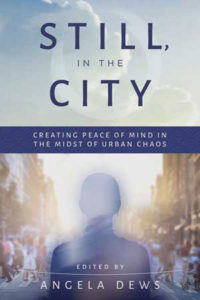Still, in the City: Creating Peace of Mind in the Midst of Urban Chaos
Reviewed by Carl Blumenthal
June 1, 2019
 Edited by Angela Dews. Skyhorse Publishing, 2018. 288 pages. $21.99/hardcover; $14.99/eBook.
Edited by Angela Dews. Skyhorse Publishing, 2018. 288 pages. $21.99/hardcover; $14.99/eBook.
Conscience or consciousness? While the demands of conscience and thus the need for draft counseling attracted some young people to Friends during the Vietnam War, others in search of heightened consciousness ignored Friends’ practice of waiting silently on the Spirit, and headed to the Far East in search of enlightenment.
Americans adapted vipassana, or “insight” meditation, downplaying the religious aspects of Theravada Buddhism that originated in Burma, Thailand, and Sri Lanka. Still meant to cultivate wisdom, it is one root of today’s more popular “mindfulness,” though the terms are often used interchangeably.
Before finding Quakers 25 years ago, I studied at the Insight Meditation Center in New York City. In addition to my lack of insight, Friends’ testimony of social justice led to my eventually accepting it over what I considered Buddhism’s solely inward approach.
In Still, in the City, long-time practitioners and teachers tell the stories of how they brought vipassana out of idyllic retreats into the nitty-gritty of New York and other cities. Racially diverse, these women and men prove Buddhism is not just for the well-being of well-off white people (like me) but a way of engaging with the world’s suffering.
While “sitting silently on the cushion” is indispensable to alignment of mind, body, and spirit, they practice mindfulness just as well when walking and biking, at bus stops, in train stations, and on subway platforms, while waiting in line at the DMV, and in traffic jams. Even a kickboxing class is an opportunity to be here now. As contributor nakawe cuebas acknowledges in “Clearly Knowing in New York”:
So, my practice has been and continues to be, anywhere, anytime, staying present both internally and externally with whatever is arising with an open heart and mind, and when I close up my heart and mind, seeing that too.
The Buddhists practice meditation with the homeless, addicts, prison inmates, the elderly, and the poor, while fighting racism, misogyny, and homophobia. The most important lesson is to love rather than judge, i.e. see that of God in everyone and everything. Vipassana is a way of living, a universal remedy for universal ills.
These two dozen brief testimonies are divided into three sections: Buddha, Awareness; Dharma, Truth; and Sangha, Love. The “three jewels” are facets of the same reality. As such, I couldn’t distinguish one type of story from another. It’s like trying to separate Friends’ individual and corporate worship from our moral witness.
The authors’ writing isn’t polished, but it is energetic; their words seem to tumble off the page. Given all their hardships, they radiate wonder and even innocence.
As Jesus was fond of metaphors, aphorisms, and parables, so, according to Margo McLoughlin, the Buddha “presented concepts like desire and restlessness, faith and generosity, by drawing comparisons to familiar sights and experiences in nature.” She continues:
[The] fickle mind is compared to a fish on dry land, flapping this way and that, or to a bird alighting wherever it wants. Craving is a creeping vine, the result of which are sorrows, growing like wild grass. In the _Saddha Sutta,_ a banyan tree serves as a metaphor for one who is consummate in faith.
When at a loss for words, these writers grab for such linguistic anchors. Tracy Cochran quotes Robert Frost: “In three words I can sum up everything I’ve learned about life. It goes on.”
There are other parallels of insight meditation to Quaker faith and practice. Bart van Melik marvels:
One thing that I really appreciate about bringing the Buddha’s teaching [to young people in jail]—even though I’ll pack it often in a secular way—is that they have that empowering quality of come and see for yourself.
Yes, there are teachers but no ministers nor rituals: only silence.
Editor Angela Dews states:
Discernment and wisdom meet my delusion. Thai Forest teacher Ajahn Chah pointed to a boulder and asked his monks, “Is it heavy?” They answered, “Yes, venerable sir.” He said, “Only if you pick it up.” The discernment is to know what I am obliged to take up.
Yet if this sounds like Friends’ “divine continuing revelation” (albeit without the “divine”), even this watered-down version of Buddhism is unlike Quaker practice in that it is highly structured. The to-do list includes: Three Pillars, Four Noble Truths, and Five Precepts, not to mention the Eightfold Path. (Check the “Notes and Links” section at the end of the book for explanations.)
Having flunked Buddhism 101 and still waiting on the Spirit to move me, I can testify vipassana meditation like Quaker worship takes intense “listening.” What did Still, in the City ultimately do for this reviewer? It led me to another book in our meeting’s library. In my opinion, Listening Spirituality, Volume II (1999) by Patricia Loring is one of the most eloquent and inspiring accounts of Quakerism. Read both books and decide for yourself what Buddhists and Quakers do and don’t have in common.



Comments on Friendsjournal.org may be used in the Forum of the print magazine and may be edited for length and clarity.